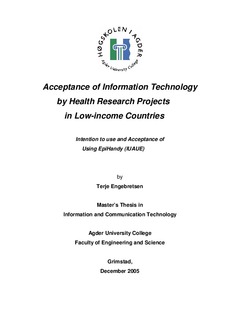| dc.description.abstract | Introduction: To better understand the data collector’s intention to use and
acceptance of using, Centre for International Health (CIH) University of Bergen (UIB)
wanted feedback on introduction of EpiHandy, by using the PROMISE EBF Mbale
site in Uganda as a pilot for collecting health data in low income countries using
PDA. The aim was to uncover some of the factors influencing or affecting the
intention to use and acceptance of the technology by the users of this system.
Method: The framework of this study was a mix of quantitative and qualitative
method. Background characteristics of the data collectors, observations using film
camera, depth interviews and the use of structured questionnaires to find out
intention and acceptance was used. Constructors like Performance Expectancy,
Social Influence, Facilitating Conditions, gender, age, experience, mandated, and
access to technology in childhood, and number of errors in the technology was used
finding level of intention and acceptance. Using Davis et al. [1998] Technology
Acceptance Model (TAM) founded on the Theory of Reasoned Action and Venkatesh
et al. [2003] Unified Theory of Acceptance and Use of Technology (UTAUT) as
baseline it was possible to observe and collect data during the field work in Uganda
and South Africa. Results: There was almost no difference in intention to use
between Uganda and South Africa, but there was indication that the data collectors
feeling of being important was different. EpiHandy was well accepted by the data
collectors due to many errors (50% failure) present in the technology, and lack of
plans introducing the technology. The results indicated that Facilitating Conditions
was the strongest constructors when it came to intention and acceptance.
Conclusion: In this study a totally new way of collecting data in a low-income
country in Africa was observed. The conclusion was that the technology was well
accepted and the intention to use and acceptance of using was high even when the
number of errors in the technology was high. This indicates also that the EpiHandy
technology will b highly accepted in South Africa and probably at the other sites in
the PROMISE EBF study as well. Acceptance of Information Technology by Health
Related Projects in Low-income Countries was high despite lack of introduction plan,
and many errors in the technology. | en |
